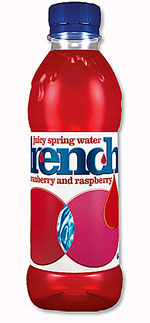 Ingredients
Ingredients- Spring water from Norwich
- Grape 6%
- Cranberry 1%
- Raspberry 1%
- Sugar
- Citric acid
- Natural flavourings
- Anthocycanin
- Potassium sorbate
- Dimethyl dicarbonate
Published May 2011
The producers, Britvic, say that this is "juicy spring water" which is true, but it contains a relatively high level of sugar, and consequently provides 145 Calories per bottle. However, there is a diet form of this drink which has only 10 Calories.
Ingredients
Spring water from Norwich originates in an underground water source (spring or bore hole) and Drench is apparently bottled at source.
Fruit juices are grape juice 6%, cranberry juice 1%, and raspberry juice 1%, all of which are natural.
Sugar is no longer seen as a healthy food but it does provide sweetness and energy. It is now being used to make biofuels by fermenting it to form ethanol (C2H5OH, aka alcohol) and a plant is being built in Hull to convert the UK's sugar beet crop into a second generation biofuel called biobutanol (C4H9OH) which can be blended with petrol better and it delivers more energy per molecule.
Citric acid (aka E330 chemical formula C6H8O7 with three acid groupings). This is produced naturally by citrus fruits but is now more cheaply manufactured by fermenting starch with the fungus Aspergillus niger. It gives the drink added tanginess and acts as a preservative.
Citric acid is used in surface cleaners to remove limescale and is particularly recommended for cleaning glass surfaces. It is added to products that are designed to fizz when added to water. The explosive HMTD (hexamethylene triperoxide diamine) is made from citric acid.
Natural flavourings are unspecified but the molecules which give fruits their characteristic aromas are known and can be purchased as individual chemicals. Those present in raspberry are 1-(p-hydroxyphenyl)-3-butanone, cis-3-hexene-1-ol, damascenone, ?-ionone, and ?-ionone, while those in cranberries they are ethyl-2-methylbutyrate, ethyl-3-methylbutryate, and trans-2-hexenal.
Some of these chemicals are also manufactured and used in perfumes. For example, ?-ionone provides a sweet violet odour while ?-ionone provides one that is reminiscent of cedar wood.
Anthocycanin (aka E163) is a food colorant and these types of molecules, of which there are several, are found in nature and give petals their red, blue or purple colours, and are designed to attract pollinating insects like bees. (The colour depends to a certain extent on acidity.)
Anthocyanins also acts as powerful antioxidants and are a key part of fruits such as red grapes, blueberries, and raspberries, which is why these are thought to be particularly beneficial. Anthocyanins also have potential for use in solar cells, the so-called dye-sensitive solar cells.
Potassium sorbate (aka E202) is a powerful preservative and used in foods and drinks. It is a highly effective fungicide that interferes with the reproductive capabilities of moulds and yeasts.
Dimethyl dicarbonate (C4H6O5) consists of two methyl carbonate molecules (CH3OC(O)OC(O)OCH3) joined together via a common oxygen atom. This molecule acts as a preservative, especially for drinks, by disabling enzymes in microbes like yeasts which can cause spoilage. It is now being added to wines in place of sulfur dioxide to which some people are sensitive.